Professional 3D Accelerators in SPECviewperf 6.1.2: March-April
2002
|
Testing in SPECviewperf 6.1.2.
In this part we will estimate performance of out participants in the SPECviewperf
tests.
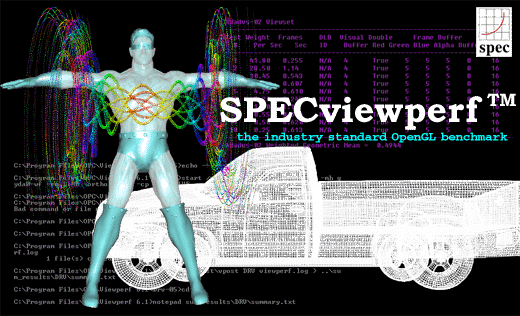
This test suite was specially developed for performance estimation of
a video subsystem of a computer under the OpenGL. Each test shows a real
operation of the card as if it works in a real application.
Here are the main differences of the tests:
- All given tests are developed and used in real applications
- All parameters of rendering and models are developed by independent software
vendors (ISVs) and users
- The results are given in fps (frames per second)
What do these tests measure? Here is a full list:
- 3D primitives, including points, lines, line_strip, line_loop, triangles,
triangle_strip, triangle_fan, quads and polygons;
- attributes per vertex, per primitive and per frame;
- lighting;
- texture mapping;
- alpha blending;
- fogging;
- anti-aliasing;
- depth buffering
This is the most complete test suite for a professional accelerator.
Advanced Visualizer Viewset

The first test is Advanced Visualizer Viewset, or AWadvs-04. Here is
its description:
- Geometric, analysis, and motion data importation from a wide range of CAD,
dynamics and structural systems.
- Automatic object simplification and switching tools for working with ultra-large
production data sets.
- Motion for an unlimited number of objects, cameras, and lights with Wavefront
SmartCurve editing techique.
- Interactive test rendering and high-quality, free-form surface rendering
- Software rotoscoping for matching computer animation with live action background
footage.
- Realistic imaging effects, including soft shadows, reflection, refraction,
textures, and displacememt maps, using Wavefront's fast hybrid scanline/raytracing
renderer.
- Interactive image layering and output to video with Wavefront's new Recording
Composer.
- Powerful scripting and customization tools, open file formats, and user-defined
interfaces.
This test combines 10 subtests:
| Test |
Weight |
Advanced Visualizer functionality represented |
| 1 |
41.8% |
Material shading of polygonal animation model with highest interactive
image fidelity and perspective projection. |
| 2 |
28.5% |
Wireframe rendering of polygonal animation model with perspective projection. |
| 3 |
10.45% |
Material shading of polygonal animation model with lowest interactive
image fidelity and perspective projection. |
| 4 |
9.5% |
Smooth shading of polygonal animation model with perspective projection. |
| 5 |
4.75% |
Flat shading of polygonal animation model with perspective projection. |
| 6 |
2.2% |
Material shading of polygonal animation model with highest interactive
image fidelity and orthogonal projection. |
| 7 |
1.5% |
Wireframe rendering of polygonal animation model with orthogonal projection. |
| 8 |
.55% |
Material shading of polygonal animation model with lowest interactive
image fidelity and orthogonal projection. |
| 9 |
.5% |
Smooth shading of polygonal animation model with orthogonal projection. |
| 10 |
.25% |
Flat shading of polygonal animation model with orthogonal projection. |
Test results:
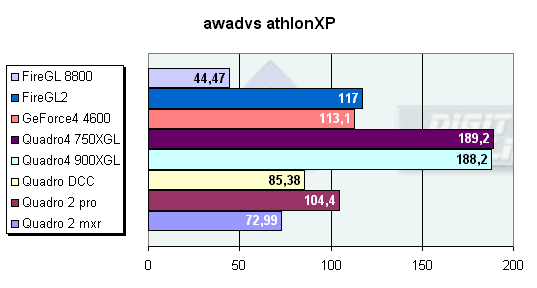

The latest NVIDIA's accelerators are leading here. By the way, on the Athlon
XP platform the Quadro4 750XGL outscores its elder brother probably because
the GPU performance is limited by the CPU one. The diagram of the Pentium
4 stand proves it.
DesignReview Viewset
The second test is DesignReview Viewset, or DRV-07.
Here is its description:

DesignReview is a 3D computer model review package specifically tailored
for plant design models consisting of piping, equipment and structural
elements such as I-beams, HVAC ducting, and electrical raceways. It allows
flexible viewing and manipulation of the model for helping the design team
visually track progress, identify interferences, locate components, and
facilitate project approvals by presenting clear presentations that technical
and non-technical audiences can understand.
On the construction site, DesignReview can display
construction status and sequencing through vivid graphics that
complement blueprints. After construction is complete, DesignReview
continues as a valuable tool for planning retrofits and maintenance.
DesignReview is a multi-threaded application that is available
for both UNIX and Windows NT.
The model in this viewset is a subset of the 3D plant model made for
the GYDA offshore oil production platform located in the North Sea on the
southwest coast of Norway. A special thanks goes to British Petroleum,
which has given the SPECopcSM subcommittee permission to use
the geometric data as sample data for this viewset. Use of this data is
restricted to this viewset.
DesignReview works from a memory-resident representation of the model
that is composed of high-order objects such as pipes, elbows valves, and
I-beams. During a plant walkthrough, each view is rendered by transforming
these high-order objects to triangle strips or line strips. Tolerancing
of each object is done dynamically and only triangles that are front facing
are generated. This is apparent in the viewset model as it is rotated.
Most DesignReview models are greater than 50 megabytes and are stored
as high-order objects. For this reason and for the benefit of dynamic tolerancing
and face culling, display lists are not used.
The updated DRV-07 shaded model contains 367178 vertices in 42821 primitives.
Vertex arrays are used to send the data to mirror the current release of
the Design Reivew application. The color and material changes are taken
directly from the GYDA model. The wire frame model contains 1599755
vertices in 94275 primitives.
There are 5 tests specified by the viewset that represent the most common
operations performed by DesignReview. These tests are as follows:
| Test |
Weight |
DRV functionality represented |
| 1 |
75% |
Walkthrough rendering of surfaces. Each object is rendered as a triangle
mesh, depth-buffered, smooth-shaded, with one light and a different color
per primitive. Material properties are changed about once every 20 primitives. |
| 2 |
13% |
For more realism, objects in the model can be textured. This test textures
the model with linear blending and mipmaps. There is a color change per
primitive and the material properties change as in test 1. |
| 3 |
4% |
As an additional way to help visual identification and location of
objects, the model may have "screen door" transparency applied. This requires
the addition of polygon stippling to test #1 above. |
| 4 |
4% |
To easily spot rendered objects within a complex model, the objects
to be identified are rendered as solid and the rest of the view is rendered
as a wireframe (line strips). The line strips are depth-buffered, flat-shaded
and unlit. Colors are sent per primitive. |
| 5 |
4% |
Two other views are present on the screen to help the user select a
model orientation. These views display the position and orientation of
the viewer. A wireframe, orthographic projection of the model is used.
Depth buffering is not used, so multithreading cannot be used; this preserves
draw order. |
Test results:
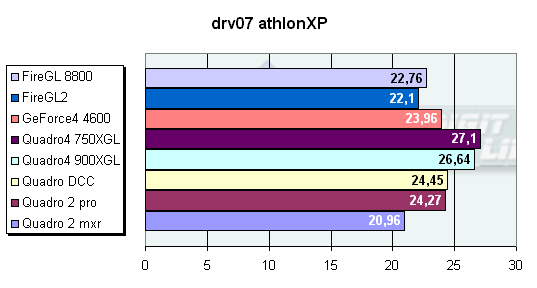

The leaders are the same, the Athlon XP still holds the accelerators back.
Data Explorer
The third suite is Data Explorer, or DX-06.
Here is its description:

The IBM Visualization Data Explorer (DX) is a general-purpose software
package for scientific data visualization and analysis. It employs a data-flow
driven client-server execution model and is currently available on Unix
workstations from Silicon Graphics, IBM, Sun, Hewlett-Packard and Digital
Equipment. The OpenGL port of Data Explorer was completed with the recent
release of DX 2.1.
The tests visualize a set of particle traces through a vector flow field.
The width of each tube represents the magnitude of the velocity vector
at that location. Data such as this might result from simulations of fluid
flow through a constriction. The object represented contains about 3,000
triangle meshes containing approximately 100 vertices each. This is a medium-sized
data set for DX.
Test Weighting
All tests assume z-buffering with one light in addition to specification
of a color at every vertex. Triangle meshes are the primary primitives
for this viewset. While Data Explorer allows for many other modes of interaction,
these assumptions cover the majority of user interaction.
The first version of this viewset included indirect rendering to handle
the client/server model of X-Windows-based systems. In this version, tests
with indirect rendering have been removed to allow the viewset to be fully
ported to Windows NT and OS/2 environments.
| Test |
Weight |
DX functionality represented |
| 1 |
40% |
TMESH's immediate mode. |
| 2 |
20% |
LINE's immediate mode. |
| 3 |
10% |
TMESH's display listed. |
| 4 |
8% |
POINT's immediate mode. |
| 5 |
5% |
LINE's display listed. |
| 6 |
5% |
TMESH's list with facet normals. |
| 7 |
5% |
TMESH's with polygon stippling. |
| 8 |
2.5% |
TMESH's with two sided lighting. |
| 9 |
2.5% |
TMESH's clipped. |
| 10 |
2% |
POINT's direct rendering display listed. |
Test results:


The situation is the same. The FireGL8800, Wildcat II 5000 and QuadroDCC
go on a par.
Lightscape Viewset
The fourth suite is Lightscape Viewset, or light-04.
Here is its description:
Lighting

The most significant feature of Lightscape is its ability to accurately
simulate global illumination effects. The system contains two integrated
visualization components. The primary component utilizes progressive radiosity
techniques and generates view-independent simulations of the diffuse light
propagation within an environment. Subtle but significant effects are captured,
including indirect illumination, soft shadows, and color bleeding between
surfaces. A post process using ray tracing techniques adds specular highlights,
reflections, and transparency effects to specific views of the radiosity
solution.
Interactivity
Most rendering programs calculate the shading
of surfaces at the time the image is generated. Lightscape's radiosity
component precalculates the diffuse energy distribution in an
environment and stores the lighting distribution as part of the
3D model. The resulting lighting "mesh" can then be rapidly displayed.
Using OpenGL display routines, Lightscape takes full advantage
of the advanced 3D graphics capabilities of SGI workstations or
PC-based OpenGL-compliant graphic acceleration boards. Lightscape
allows you to interactively move through fully simulated environments.
Progressive Refinement
Lightscape utilizes a progressive refinement
radiosity algorithm that produces useful visual results almost
immediately upon processing. The quality of the visualization
improves as the process continues. In this way, the user has total
control over the quality (vs. time) desired to perform a given
task. At any point in the solution process, users can alter the
characteristic of a light source or surface material and the system
will rapidly compensate and display the new results without the
need for restarting the solution. This flexibility and performance
allow users to rapidly test various lighting and material combinations
to obtain precisely the visual effect desired.
There are four tests specified by the viewset that represent the most
common operations performed by the Lightscape Visualization System:
| Test |
Weight |
Lightscape functionality represented |
| 1 |
25% |
Walkthrough wireframe rendering of "Cornell Box" model using line loops
with colors supplied per vertex. |
| 2 |
25% |
Full-screen walkthrough solid rendering of "Cornell Box" model using
smooth-shaded z-buffered quads with colors supplied per vertex. |
| 3 |
25% |
Walkthrough wireframe rendering of 750K-quad Parliament Building model
using line loops with colors supplied per vertex. |
| 4 |
25% |
Full-screen walkthrough solid rendering of 750K-quad Parliament Building
model using smooth-shaded z-buffered quads with colors supplied per vertex. |
Test results:


medMCAD-01 Viewset
The fifth suite is medMCAD-01 Viewset, or medMCAD-01.
Here is its description:

Unlike other viewsets, the medMCAD-01 viewset is a 'generic' viewset
i.e. it is representative of a class of applications rather than a single
application. The medMCAD-01 viewset is intended to model the graphics performance
of a range of medium scale, immediate mode, MCAD applications such as Pro/ENGINEER(TM)
from PTC and SolidWorks from SolidWorks Corporation.
The viewset consists of twelve tests, each of which represents a different
mode of operation. Four of the tests use a wireframe model, and the other
tests use a shaded model. All tests use immediate mode and vertex arrays
(glDrawArrays). Each test has two runs: a) with orthographic projection,
and b) with perspective projection, zoom and pan (walkthru). Each test
returns a result in frames per second, and a composite score is calculated
as a weighted geometric mean of the individual test results. The tests
are weighted to represent the typical proportion of time a user would spend
in each mode.
This viewset uses new features that require SPECviewperf!" 6.1.2.
The shaded model uses 47,000 triangle strips with approximately 444,000
vertices resulting in 349,000 triangles total. There are no discrete triangles.
The average triangle screen area is approximately 17 pixels. The maximum
depth complexity is 34 with an approximate mean depth complexity of 8.
The wire frame model consists of 26,500 line strips, with around 192,000
vertices giving 120,000 lines total. The mean line length is 7 pixels.
The wireframe tests use aliased lines, since these still are the default
for many immediate mode MCAD applications. The shaded tests use either
one ore two infinite lights with normalization enabled. Lighting is single
sided. There is no texture mapping. See the script files for more information.
| Test |
Weight |
Description |
| 1 |
10 |
Wireframe test, no Z, orthographic projection |
| 2 |
10 |
Wireframe test, no Z, perspective projection, walkthrough |
| 3 |
10 |
Wireframe test, color-per-primitive, Z, user clipplane test, orthographic
projection |
| 4 |
10 |
Wireframe test, color-per-primitive, Z, perspective projection, walkthrough |
| 5 |
7.5 |
Shaded test, Z, back face removed, orthographic projection |
| 6 |
7.5 |
Shaded test, Z, user clipplane, perspective projection, walkthrough |
| 7 |
7.5 |
Shaded color-per-primitive test, Z, back face removed, orthographic
projection |
| 8 |
7.5 |
Shaded color-per-primitive test, Z, back face removed, perspective
projection, walkthrough with screen door transparency |
| 9 |
7.5 |
Shaded color-per-vertex test, Z, back face removed, orthographic projection. |
|
10
|
7.5 |
Shaded color-per-vertex test, Z, user clipplane, perspective projection,
walkthrough |
|
11
|
7.5 |
Shaded test with two infinite lights, Z, back face removed, orthographic
projection |
| 12 |
7.5 |
Shaded test with two infinite lights, Z, back face removed, perspective
projection, walkthrough |
Test results:
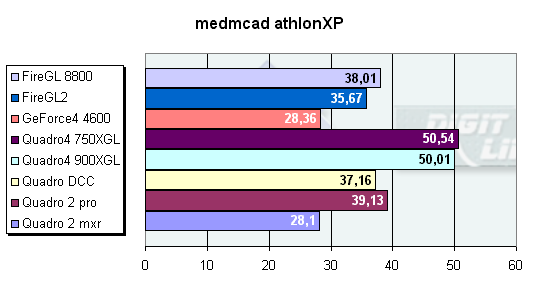
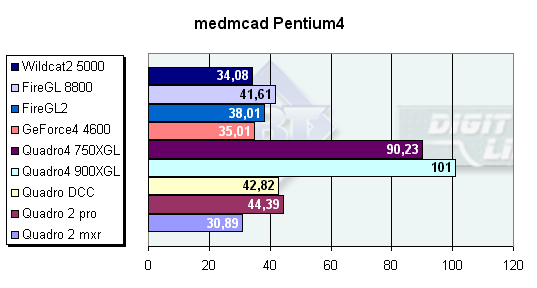
ProCDRS-03 Viewset
The last test is ProCDRS-03 Viewset, or ProCDRS-03.
Here is its description:

The ProCDRS-03 viewset is an update to ProCDRS-02 (which was a complete
update of the CDRS-03 viewset). It is intended to model the graphics performance
of Parametric Technology Corporation's CDRS industrial design software.
The viewset consists of ten tests, each of which represents a different
mode of operation within CDRS. Two of the tests use a wireframe model,
and the other tests use a shaded model. Each test returns a result in frames
per second, and a composite score is calculated as a weighted geometric
mean of the individual test results. The tests are weighted to represent
the typical proportion of time a user would spend in each mode.
The model data was converted from OpenGL command traces taken directly
from the running CDRS software, and therefore preserves most of the attributes
of the original model.
This viewset uses features that require SPECviewperf(TM) 6.1.2.
The new ProCDRS-03 viewset doubles the display list size by adding a
second truck to the frame. The triangle and line counts increased accordingly.
The shaded model is a mixture of triangle strips and independent triangles,
with approximately 562,000 vertices in 9,300 OpenGL primitives, giving
262,000 triangles total.
The wire frame model consists of only line strips, with around 404,000
vertices in 37,000 strips, giving 388,000 lines total.
All tests run in display list mode. The wireframe tests use anti-aliased
lines, since these are the default in CDRS. The shaded tests use one infinite
light and two-sided lighting. The texture is a 512 by 512 pixel 24-bit
color image. See the script files for more information.
| Test |
Weight |
Description |
| 1 |
25 |
Wireframe test |
| 2 |
25 |
Wireframe test, walkthrough |
| 3 |
10 |
Shaded test |
| 4 |
10 |
Shaded test, walkthrough |
| 5 |
5 |
Shaded with texture |
| 6 |
5 |
Shaded with texture, walkthrough |
| 7 |
3 |
Shaded with texture, eye linear texgen (dynamic reflections) |
| 8 |
3 |
Shaded with texture, eye linear texgen, walkthrough |
| 9 |
7 |
Shaded with color per vertex |
| 10 |
7 |
Shaded with color per vertex, walkthrough |
Test results:
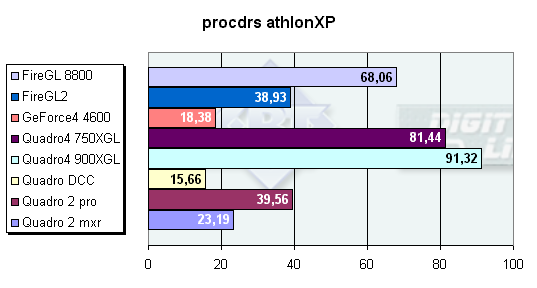

The FireGL 8800 takes the third position after the Quadro4 line.
And now let's combine the fps of the cards and find out which is better:

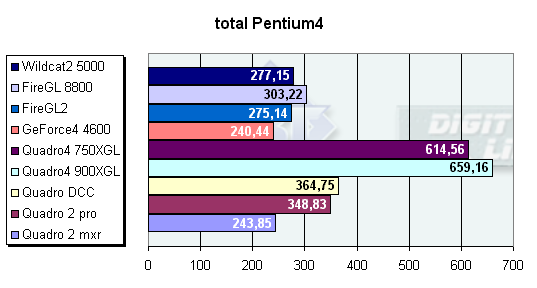
These are very tough professional tests, and the game accelerator drags
behind.
Conclusion
In these tests the NVIDIA products are undoubtedly leaders. The latest
Quadro4 cards are far ahead. Although the tests are synthetic, the 3D MAX
proves that the Quadro4s are the best. The Quadro DCC model also has quite
good results.
The FireGL 8800 is a successful product indeed. The only thing that
the developers have to do is to correct the drivers to avoid errors in
the 3D MAX. However, even if they do it, ATI is half a year late. The FireGL
8800 was intended to be a competitor against Quadro4 750XGL both in price
and in performance, but it fights against the Quadro4 750XGL not very well,
as well as against the Quadro DCC and Quadro2 PRO. Well, better late than
never.
The Wildcat II 5000 shows the most stable results. Taking into account
that it lacks for any quality problems I could recommend you this card...
if not the price. At such price one can get a more efficient modern accelerator.
The FireGL2, Quadro2 PRO and Quadro2 MXR remain in the shadow of their
elder brothers. Their speed and quality are rather good, but they are still
less efficient.
As for the platforms, the Intel's one seems an optimal solution
for professional applications, and the AMD's platform suits better
for games. In our further tests we won't use a stand based on the
AMD processors any more, at least, until professional applications
are optimized for them.
Write a comment below. No registration needed!
|
|
 |
|
|
|
















